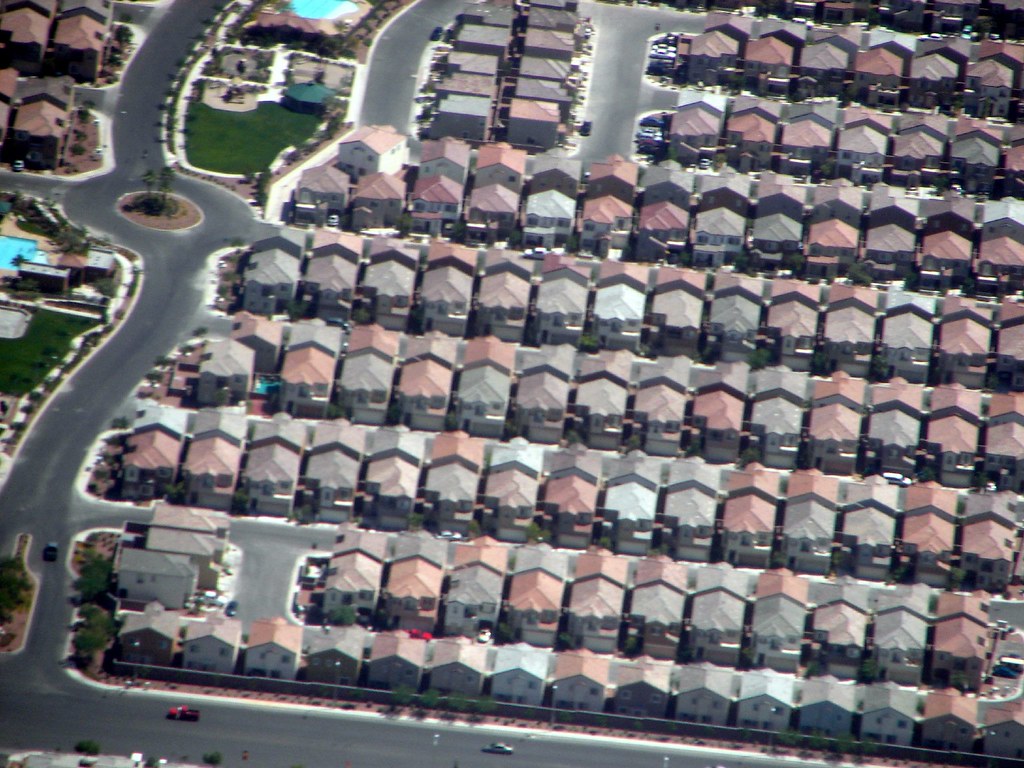
Nocturne: in a new suburb by Tadeusz Deręgowski
How do suburban landscapes affect the people who live there? What impressions do they leave on you on first encounter, or after long exposure?
The first literary references that come to my mind are not favorable ones. In A Wrinkle in Time, when Meg and Calvin make their first incursion into Camazotz, a planet that has completely succumbed to “evil”, they first encounter that evil in the form of a Monotonous Neighbourhood:
Below them the town was laid out in harsh angular patterns. The houses in the outskirts were all exactly alike, small square boxes painted gray. Each had a small, rectangular plot of lawn in front, with a straight line of dull-looking flowers edging the path to the door. Meg had a feeling that if she could count the flowers there would be exactly the same number for each house.
C.S. Lewis did much the same thing in The Great Divorce. The idea of an endless grid of identical houses serves, for him, as a vision of hell itself:
Several hundred feet below us, already half hidden in the rain and mist, the wet roofs of the town appeared, spreading without a break as far as the eye could reach. …We were now so high that all below us had become featureless. But fields, rivers, or mountains I did not see, and I got the impression that the grey town still filled the whole field of vision.
He could almost be flying out of Boston or D.C. with that kind of description. Lewis describes an infernal social dynamic whose result strongly resembles urban sprawl.
Further notes to this post will focus on other “found impressions” of the suburbs by authors, artists, journalists, and architects.




Tavi Gevinson’s interview of Lorde this last January touches on suburban aesthetics:
— Joel (Author) ·
Sprawl II (Mountains Beyond Mountains), from The Suburbs album by Arcade Fire, mentioned by Lorde in the above note.
That we can never get away from the sprawl,
Living in the sprawl,
Dead shopping malls rise like mountains beyond mountains,
And there’s no end in sight,
I need the darkness someone please cut the lights.
I find it notable that the song cuts to a Shepard tone midway through: a sound that always descends without ever actually going anywhere.
— Joel (Author) ·
One of my favorite groups on Flickr is “Suburbanality.” Its contents are quiet commentary on the good and the bad of the suburbs.
[THE LOCAL YARN CHIPS IN: Here's the link!]
— Karl ·
The painter Scott Lloyd Anderson, on his series Paradise Paved:
Art often works by drawing our eye to beauty in unlikely places. But it seems that every attempt to create art around suburban landscapes begins with an admission that the suburbs are inherently ugly.
— Joel (Author) ·
I have to admit I am a fan of the despair that is unique to the suburbs. It is neither the sinister loneliness found in a Flannery O’Connor story nor the claustrophobic hopelessness found in a movie like Se7en. No, suburban despair has the unique aspect of highlighting the tension between how we appear to the world and how we actually are. To put it fancier terms, it highlights the difference between being and seeming. One film that is chock-full of examples is American Beauty, and I’m just going to point out one, Lester played by Kevin Spacey (clip likely NSFW).
Lester feels like a bumbling oaf, yet feels that he is meant for something else. He seems to be something, yet is something else. This pains him to be, in the words of Holden Caulfield, a phony. Now the rest of his actions in the film are hardly defensible as he tries to become himself. By the end of movie, as he is about sleep with an underage girl in what is supposed to be the crown jewel in his project of self-actualizing, he realizes that this childish striving is futile as well. He unfortunately meets a tragic end just as he realizes this.
As creatures, finite and temporal, we are constantly becoming and never static. We are painfully caught between what could and ought to be and what we are. With the ability to have rich inner lives comes the burden of appearing and being. The realignment of our disparate nature is a life’s work. The aesthetic of the suburban, grossly inorganic and sterilized, make us painfully aware of this tension.
— Nathaniel Torrey ·
The end of neighbors →
Brian Bethune, writing for MacLean’s:
— Joel (Author) ·